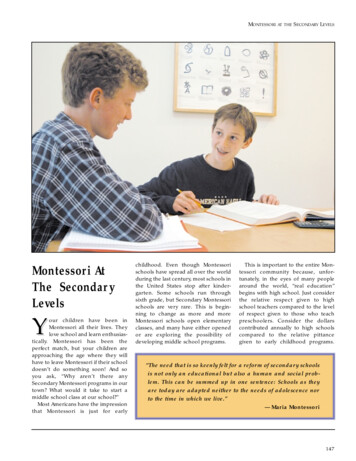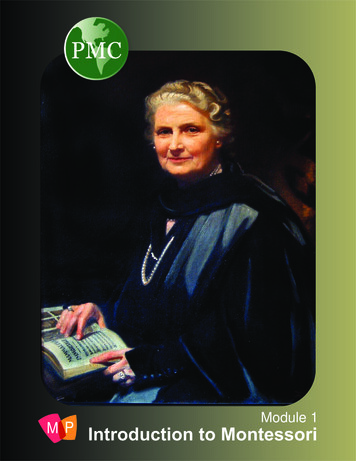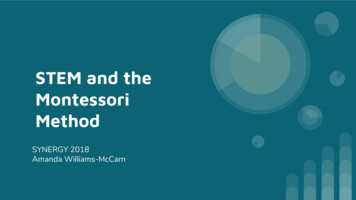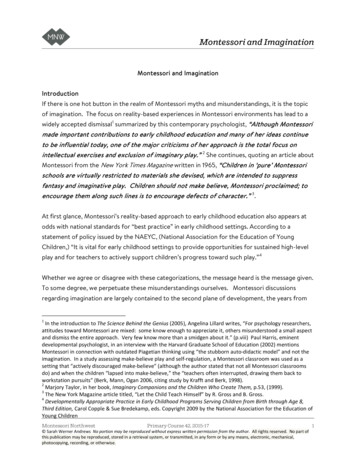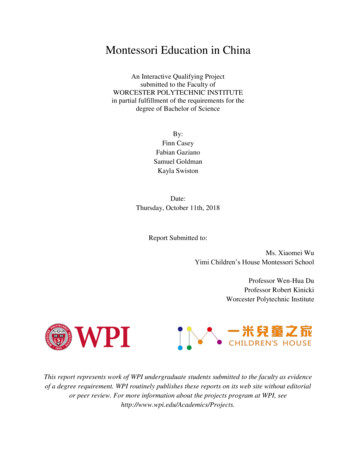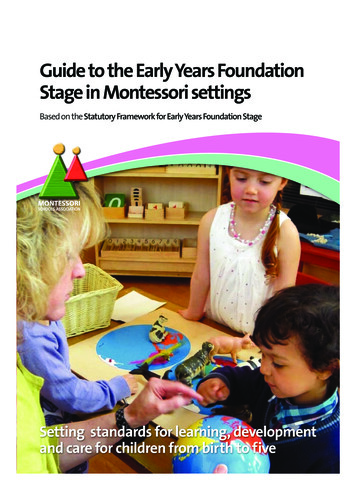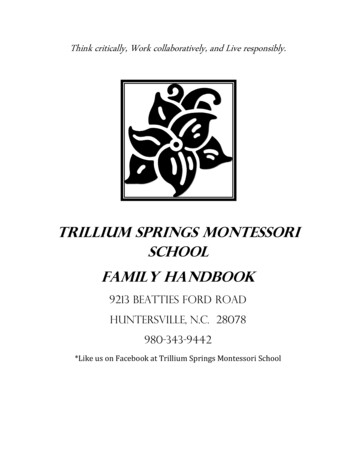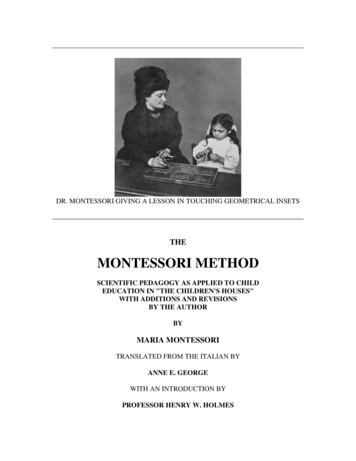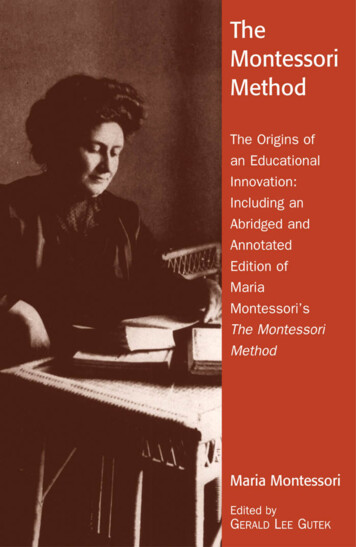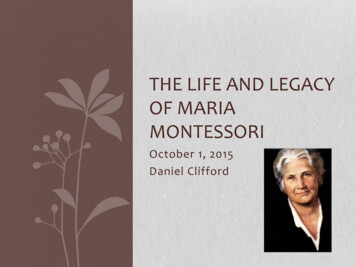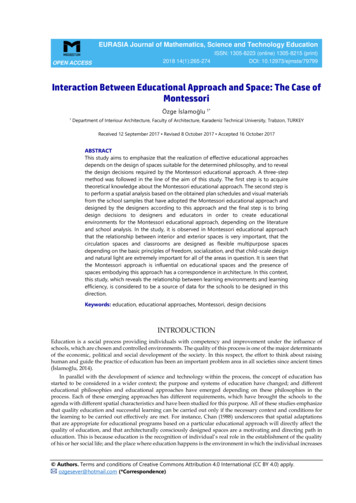
Transcription
Issue 8October—December 2020MONTESSORI MEMO A quarterly, curated memo of peerreviewed research and policy papersaccessible and contributed to by abroad community of Montessori andnon-Montessoriresearchersandpractitioners via our community foundat www.Montessori-Forward.org.RESEARCH: MONTESSORITitle Determining and Comparing the Effect of Traditional andMontessori Methods on Perceptual Motor Activities of ElementarySchool StudentsCitationINSIDE THIS ISSUEResearch: Montessori .1Research: Related .6HOW TO GET INVOLVEDIndividual researches, practitioners,and community members areencouraged to recommend peerreviewed research and policy papersthat you find relevant via the formfound on www.MontessoriForward.org.The Center for Montessori Studiescollaborates across the Montessoricommunity, Association MontessoriInternational and AmericanMontessori Society, and values theinstitutional collaborations with andamong KU Center for MontessoriResearch, National Center forMontessori in the Public Sector, andMontessori Public Policy Initiative.Adibpour, N., & Hasanvand, B. (2020). Determining and comparing theeffect of traditional and Montessori methods on perceptual motoractivities of elementary school students. Journal of Motor andBehavioral Sciences, 3(3), 303–312. http://www.jmbs.ir/article 118239 13995.html?lang enSummary/Abstract The purpose of this study is to determine andcompare the effect of traditional and Montessori methods onperceptual motor activities of elementary school students. Thisresearch is applied in terms of purpose and semi-experimental interms of implementation. Abad forms. The sample size in this studywas selected using G-POWER software and the sample size was 36people. It is necessary that three groups of 12 people are selectedrandomly from them. In this study, there are three groups of 12people for research, one of which is the Montessori training program;In the second group, the traditional training program and the thirdgroup as a research control group, in which the two experimentalgroups performed the necessary training sessions for 8 weeks and 3sessions per week. In both traditional and Montessori groups, thechanges in pre-test and post-test are significant and this means thatboth Montessori and traditional methods have been able to improvestudents' balance. The results showed that the Montessori group hadthe greatest impact on fine motor skills. Also, the traditional traininggroup was able to create a significant difference with the controlgroup.Montessori Memo 2021 Center for Montessori Studies
Title Teachers’ Perceptions of Supporting Pre-School Children in Self-Learning in MontessoriClassrooms: A Case Study of Three Saudi Pre-SchoolsCitationAlmajed, M. A. (2020). Teachers’ perceptions of supporting pre-school children in self–learning inMontessori classrooms: A case study of three Saudi pre-schools. Multi-Knowledge ElectronicComprehensive Journal For Education And Science Publications, 37, 1-21. https://www.mecsj.com/uplode/images/photo/Teachers Perceptions of Supporting Pre-School Children.pdfSummary/Abstract Teaching at pre-school in Saudi Arabia can involve the use of many types ofteaching methods, and the Montessori educational system is one approach that can be used. Over time,this method has gained value and popularity due to its promotion of a self-learning strategy. This currentstudy aims to explore the perceptions of Montessori teachers working in Saudi Arabia about their role insupporting a self-learning strategy for pre-school children. The research sample comprised Montessoriteachers working at three schools in Saudi Arabia. Data was collected by undertaking qualitative semistructured interviews and using an unstructured questionnaire. The interviews was piloted in advanced.The findings show that most of the Saudi pre-school teachers who participated are knowledgeable aboutteaching the Montessori system in the classroom, and have knowledge of applying the self-learningstrategy. However, in practice, their role in supporting children to achieve self-learning is affected byvarious factors, including: the overall ethos of the Saudi education system, the Ministry of Education’sperceptions about teaching pre-school children using the Montessori system, the teacher’s backgroundand their years of experiences working with pre-school children, and the use of individual education plansfor each child.TitleFour Pillars of the Montessori Method and Their Support by Current NeuroscienceCitationCatherine, L., Javier, B., & Francisco, G. (2020). Four pillars of the Montessori method and their supportby current neuroscience. Mind, Brain, and Education, 14(4), 322–334. doi.org/10.1111/mbe.12262Summary/Abstract Maria Montessori developed an educational program during the first half of the20th century. Nowadays, the Montessori method (MM) is considered one of the main alternatives toteacher‐paced conventional preschool education. This review aims to open a dialogue between the MMand current understanding of neurodevelopment. Four conceptual pillars of the MM—the sensitiveperiods, the education of the senses, the prepared environment, and spontaneous activities throughrepetition—are discussed. According to the MM, the teacher provides children with an environment that,leaning on maturational time windows, should promote sensory development through spontaneousrepetition. We describe brain changes in 3‐ to 6‐year‐old children due to development and externally‐provided experience. Then, it is discussed whether these pillars are supported by neuroscience. Finally,the influences of Montessori are explained, and we suggest possible lines of research to underpin theneuroscientific grounds of the MM.Title2Children’s Automatic Evaluation of Self‐Generated Actions is Different from AdultsMontessori Memo — Quarterly, Curated, and CollaborativeIssue 8
CitationDenervaud, S., Hess, A., Sander, D., & Pourtois, G. (2020). Children’s automatic evaluation of selfgenerated actions is different from adults. Developmental Science, e13045. doi.org/10.1111/desc.13045Summary/Abstract Performance monitoring (PM) is central to learning and decision making. It allowsindividuals to swiftly detect deviations between actions and intentions, such as response errors, andadapt behavior accordingly. Previous research showed that in adult participants, error monitoring isassociated with two distinct and robust behavioral effects. First, a systematic slowing down of reactiontime speed is typically observed following error commission, which is known as post-error slowing (PES).Second, response errors have been reported to be automatically evaluated as negative events in adults.However, it remains unclear whether (1) children process response errors as adults do (PES), (2) they alsoevaluate them as negative events, and (3) their responses vary according to the pedagogy experienced.To address these questions, we adapted a simple decision-making task previously validated in adults tomeasure PES as well as the affective processing of response errors. We recruited 8-to-12-year-oldchildren enrolled in traditional (N 56) or Montessori (N 45) schools, and compared them to adults (N 46) on the exact same task. Results showed that children processed correct actions as positive events,and that adults processed errors as negative events. By contrast, PES was similarly observed in all groups.Moreover, the former effect was observed in traditional schoolchildren, but not in Montessorischoolchildren. These findings suggest that unlike PES, which likely reflects an age-invariant attentionorienting toward response errors, their affective processing depends on both age and pedagogy.Title Intervention Fidelity of a Volunteer-Led Montessori-Based Intervention in a Canadian Long-TermCare HomeCitationHunter, P., Rissling, A., Pickard, L., Thorpe, L., & Hadjistavropoulos, T. (2020). Intervention fidelity of avolunteer-led Montessori-based intervention in a Canadian long-term care home. Canadian Journal onAging / La Revue Canadienne Du Vieillissement, 1-13. doi:10.1017/S071498082000029XSummary/Abstract Montessori-based interventions (MBIs) were developed to promote guidedparticipation in meaningful activities by people with dementia patients. In this study, we assessed nursinghome volunteers’ fidelity to an MBI, relying primarily on a qualitative descriptive design. We completed adeductive content analysis of eight volunteer interviews using the Conceptual Framework forIntervention Fidelity. We also calculated average volunteer and resident scores on the Visiting QualityQuestionnaire (VQQ), which assesses volunteers’ and residents’ perceptions of visits. We found goodevidence that volunteers attended scheduled visits, made use of pre-designed activities, and attended totraining recommendations. Most reported enjoying the visits (VQQ 6.12, standard deviation [SD] 0.75) and receiving a positive response from residents (VQQ 5.46, SD 0.88). Nevertheless, use ofpre-designed activities and response to the MBI was lower for volunteers working with residents who hadlate-stage dementia. Therefore, overall, fidelity depended on the cognitive status of the resident.TitleMontessori as a School Reform Alternative Reflecting Biblical AnthropologyCitationJeong, J. (2020). Montessori as a school reform alternative reflecting biblical anthropology. Journal ofResearch on Christian Education, 29(3), 307–327. essori Memo — Quarterly, Curated, and CollaborativeIssue 8
Summary/Abstract Today’s education has three impediments to meaningful and sustainableeducational reform; first, the lack of precise and accurate anthropology of learners; second, dilemmabetween constructivism-leading academy and behaviorism-dominating classrooms; third, the lack ofphilosophy of education in theory and practice. The Montessori system was built upon the Christiantheological anthropology, which uncovers that the main source of failure in our education is humanity’soriginal sin and sins preventing us from fulfilling the Imago Dei or the reciprocating self. This articlehighlights why the Montessori method is a feasible school reform model by briefly examiningMontessori’s anthropology centering on Imago Dei, teacher’s respect for the child resulting in educationthrough being and embodiment, and systematized teacher-training system.TitlePeace Education: A Case Study of a Montessori School in LebanonCitationKotob, M., & Antippa, V. (2020). Peace education: A case study of a Montessori school in Lebanon.Millennium Journal of Humanities and Social Sciences, 44–68. doi.org/10.47340/mjhss.v1i3.4.2020Summary/Abstract Lebanon suffered a civil war that has torn its society. The third generation is stillliving the instability and conflicts that their grandparents experienced when the war started forty-fiveyears ago. Nowadays, there is a need of a substantial change and children have the power of creatingpeace and making a major transformation of the society. Therefore, educators should believe in children’spower. The inclusion of a practical Peace Education Program in the Lebanese National Curriculum is, fromthe perspective of the researches, the tool children need to lead the future transformation. PeaceEducation can help them to know themselves and understand that everyone is an important part of thecommunity and the country. Accordingly, this study examines the Peace Education Program at the firstMontessori School in Lebanon and the teachers’ level of awareness of implementing it through theirteaching practices. The level of awareness is related to the four pillars to be developed in the studentsaccording to the Montessori approach to Peace Education: Self-awareness, community-awareness,cultural-awareness, and environmental-awareness. The results of the study show that the director andthe teachers have the adequate knowledge and awareness about this approach and they implement it,complying with Montessori’s principles and concepts.TitleMontessori as an Alternative Early Childhood EducationCitationLillard, A. S. (2020). Montessori as an alternative early childhood education. Early Child Development andCare, 1–11. act Montessori education was developed over 100 years ago, and persists as amarginal ‘niche reform’ of the standard model. Here I discuss two unresolved dichotomies in earlychildhood education – the tension between work and play, and between structure and freedom. I explainhow Montessori collapses and thereby resolves the dichotomies, and does so in a contemporarytheoretical frame – one that is dynamical rather than linear. I next describe the origins and functioning ofMontessori preschool environments, outcomes from the most methodologically sound studies to date,and impediments to Montessori’s more widespread adoption. I also show how Montessori is a culturallyresponsive pedagogy, and conclude by returning to the dichotomies and how Montessori makes sense forthe modern era.4Montessori Memo — Quarterly, Curated, and CollaborativeIssue 8
Title Interaction of Children with and without Communication Disorders using Montessori Activitiesfor the TabletCitationPérez-Pérez, J.-R., Cabielles-Hernández, D., Sánchez-Santillán, M., & Paule-Ruiz, M. P. (2020). Interactionof children with and without communication disorders using Montessori activities for the tablet. Personaland Ubiquitous Computing. doi.org/10.1007/s00779-020-01471-7Summary/Abstract Mobile technologies used for education may offer advantages for children withCommunication Disorders, among which we can find language disorders and speech disorders, which areidentified in DSM-V. In this research, we have introduced two educational activities, “Matching Cards” and“Cards & Sounds”, based on the Montessori Method and which deal with the first stages of reading andwriting. We have tested these two activities with children with and without Communication Disorders inorder to study how they interact. These groups of children use a Tablet to perform the two activities,which vary in visual and auditory stimuli. The activities employ two touch interactions: tap and drag &drop. Based on Montessori, the activity and the interaction do not produce either positive or negativefeedback. The analysis performed with the variables of time, interaction and mistake has shown thatchildren from both groups change their efficiency of use. Differences regarding the interaction of childrenwith and without Communication Disorders have also been observed. Additionally, children withCommunication Disorders need additional strategies as explicit indicators in the interaction which may bea guide to be able to carry out specific actions.Title Understanding Teacher Identity Construction: Professional Experiences of Becoming IndonesianMontessori TeachersCitationSiswanto, I. L., & Kuswandono, P. (2020). Understanding teacher identity construction: Professionalexperiences of becoming Indonesian Montessori teachers. Indonesian Journal of English LanguageTeaching and Applied Linguistics, 5(1), 1–16. doi.org/10.21093/ijeltal.v5i1.539Summary/Abstract This study sought to investigate the identity construction of Indonesian Montessoriteachers. The research was done in two Montessori schools in Yogyakarta: Cosmic School and UniverseSchool (pseudonyms). The participants involved in this research were eight teachers in total. The datagathering process employed questionnaire, classroom observation, interview, and written reflections. Thefindings have shed a light on the ways teachers develop their identities within Montessori’s values andprinciples that they reflect and implement in their daily teaching practice. The findings of the researchportrayed that there were four major salient principles influencing the identity formation of becomingMontessori teachers. They were movement and cognition, choice, interest, and teacher ways and childways. Those principles and values were becoming teachers’ guidance of creating professional workingethos. Montessori principles also influenced the teachers in the ways they perceived and treated thestudents. This study also revealed the undertaken agencies to hold identity as Montessori teachers. Therewere three broad themes to explain their agencies. They entailed the essence of building communicationbetween teacher and parents, the significance of community support, and the importance of being wellprepared teachers. Based on the findings and discussion, some recommendations for future studies arealso presented.5Montessori Memo — Quarterly, Curated, and CollaborativeIssue 8
Title The Reception of Maria Montessori’s Pedagogical Theory in Pre-School Education in InterwarPolandCitationSosnowska, J. (2020). The reception of Maria Montessori’s pedagogical theory in pre-school education ininterwar Poland. Nauki o Wychowaniu. Studia Interdyscyplinarne, 11(2), 106–124. doi.org/10.18778/2450-4491.11.09Summary/Abstract An innovative trend in pedagogy, called "new education", which appeared in manyEuropean countries in the first half of the 20th century, aimed at the renewal of the school, learningconditions and the learning process, assigned a new role to the teacher, and emphasized a new approachto the child. One of the many representatives of the "new education" was Maria Montessori (1870–1952),an Italian doctor and educator. Learning about M. Montessori's pedagogical theory in Poland wassupported by her book publications and the pedagogical and psychological literature of Polish educators,which referred to the concept of Montessori education. The aim of the article is to present the receptionof M. Montessori's pedagogical theory in preschool education in the years 1918–1939.RESEARCH: RELATEDTitle Montessori, Waldorf, and Reggio Emilia: A Comparative Analysis of Alternative Models of EarlyChildhood EducationCitationAljabreen, H. (2020). Montessori, Waldorf, and Reggio Emilia: A comparative analysis of alternativemodels of Early Childhood Education. International Journal of Early Childhood. doi.org/10.1007/s13158020-00277-1Summary/Abstract Montessori, Waldorf, and Reggio Emilia education remain three of the mostpopular models for alternative early childhood education. Each of these approaches has developedglobally, with a rich history of supporting children’s educational freedom. This narrative analysis providesa means for early childhood educators and scholars to understand the aims, philosophical and theoreticalframeworks, historical development, benefits, and challenges in these models and their methods ofpractice. As early childhood education evolves with technology and as re-conceptualizations about earlyeducation occur, an understanding of these alternatives to traditional education models is important.While adaptive options of these models may emerge in education systems across national contexts, thisreview allows educators to consider their applications and cultural appropriateness in specific local andcommunity contexts.TitleLead It!: An App to Enable Persons With Dementia to Lead Group Activities for Their PeersCitationSkrajner, M., & Gorzelle, G. (2020). Lead It!: An app to enable persons with dementia to lead groupactivities for their peers. Innovation in Aging, 4(Suppl 1), 274–275. doi.org/10.1093/geroni/igaa057.878Summary/Abstract LEAD IT! is an app that enables persons with early and middle stage dementia tolead activities for their peers—i.e., other persons with dementia (PWD). An alpha version of the app was6Montessori Memo — Quarterly, Curated, and CollaborativeIssue 8
tested in a Phase 1 SBIR project. The alpha version included three Montessori-inspired activities. WhilePWD ostensibly view LEAD IT! as a set of enjoyable activities, it is actually an evidenced-basedintervention aimed at reducing responsive behaviors and enabling PWD to fill meaningful social roles. Atotal of 24 PWD participated in the Phase 1 study: five leaders and 19 players. LEAD IT! Programming wasimplemented for six weeks, twice per week. LEAD IT! produced higher levels of positive engagement andaffect, and lower levels of negative engagement, as compared to standard, baseline activities—i.e., nondigital activities led by staff. More specifically, when compared to baseline programming, playersexhibited an 82% increase in Constructive Engagement (P 0.000), 80% increase in Passive Engagement(P 0.000), 60% reduction in Other Engagement (P 0.035), and 171% increase in Pleasure (P 0.000). Onelimitation of the Phase 1 study is that, at least insofar as the intervention is only implemented twice perweek for six weeks, the positive outcomes seem to be limited to the period of time during which PWD areparticipating in the activity—i.e., changes on global measures, such as quality of life and depression werenot detected. Still, the promising results of this study suggest that LEAD IT! is worthy of furtherdevelopment and evaluation in a planned Phase 2 study.Title Understanding School Engagement: The Role of Contextual Continuities and Discontinuities inAdolescents’ Learner IdentitiesCitationVerhoeven, M., Zijlstra, B., & Volman, M. (2021). Understanding school engagement: The role ofcontextual continuities and discontinuities in adolescents’ learner identities. Learning Culture and SocialInteraction, 28. doi.org/10.1016/j.lcsi.2020.100460Summary/Abstract Adolescents' school engagement is related to continuities and discontinuities inlearning notions between various contexts (e.g., school, home, peer groups). Learning notions are theprevalent ideas in a context about appropriate learning goals, contents and means. It has remainedunclear how adolescents' learner identities mediate the role that (dis-)continuities play in adolescents'school engagement. To advance insight into adolescents' school engagement, we examined whatrelations could be found between various contextual (dis-)continuities in learning notions adolescentswith diverse levels of school engagement experience and their learner identities. Our comparative casestudy suggests that especially (dis-)continuities regarding notions of what it entails to be a good learnerand the importance of being one between the school context on the one hand, and the contexts of homeand peer groups on the other inform students' school-related learner identities. The present study impliesthat adolescents' school engagement can be fostered by building continuities between school and homein the appreciation of students' efforts and by making them resilient to unconstructive learning notions inhome and peer group contexts.TitleStatus of Peace Learning through Curriculum Based Activities in College Students: A SurveyCitationYadav, M. M., & Tiwari, D. S. (2020). Status of peace learning through curriculum based activities incollege students: A survey. PalArch’s Journal of Archaeology of Egypt / Egyptology, 17(6), p/jae/article/view/4054Summary/Abstract To investigate the current scenario related to activities helping students aboutpeace learning in higher education, a survey of randomly selected 600 students of higher education was7Montessori Memo — Quarterly, Curated, and CollaborativeIssue 8
carried out in the Rajasthan state of India studying in science, commerce and humanities. Survey througha reliable and valid self-made checklist was done. Checklist constituted for a list of ten different academicand co-curricular activities usually organized in the colleges. Students’ responses on the checklist wasqualitatively analyzed. Major findings in terms of their observations were included that activities likesports and games, debates and extempore, clubs events, seminar-conferences, class room teachinglearnings and cultural programs organizing in higher education institutions are promoting peace learningrelated ideas at average level whereas activities planned related to assemblies, training programs,workshops and discussion forums are not sufficiently organized for peace learning in the i Memo is a resource found via the Montessori Forwardwebpage. A contemporary format for people to learn about Montessorieducation. Montessori Forward is the shared effort of the Center forMontessori Studies, University of Hartford degree programs, and theMontessori Training Center Northeast to sustain a virtual space as well asan intellectual community for researchers and practitioners contributingto Montessori education and research.Disclaimer: The views, data, and conclusions expressed herein are those of theoriginal authors of the studies and papers; they do not necessarily reflect theviews of or receive endorsement from the Center for Montessori Studies.8Montessori Memo — Quarterly, Curated, and CollaborativeIssue 8
teaching methods, and the Montessori educational system is one approach that can be used. Over time, this method has gained value and popularity due to its promotion of a self-learning strategy. This current study aims to explore the perceptions of Montessori
